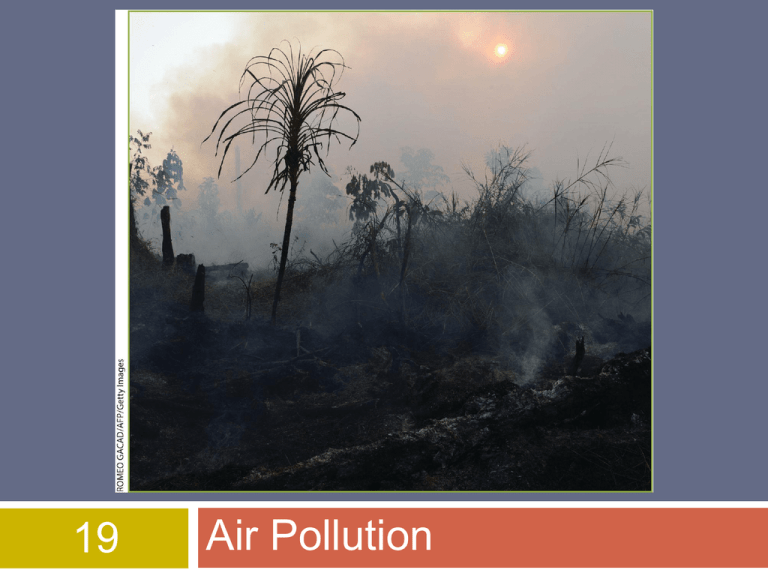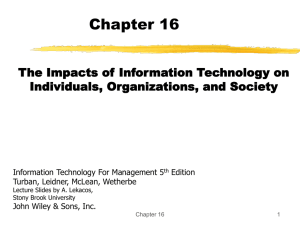
19
Air Pollution
Overview of Chapter 19
Atmosphere as a Resource
Types and Sources of Air Pollution
Effects of Air Pollution
Controlling Air Pollution in the US
Ozone Depletion in the Stratosphere
Acid Deposition
Air Pollution Around the World
Indoor Air Pollution
© 2015 John Wiley & Sons, Inc. All rights reserved.
Forest burning in Sumatra
Fires are set to clear forests for planting
Burning results in severe air pollution
Silviculture (commercial production of forest
products)
Smoke is full of small
particles that can lodge in
lungs and cause
illness/disease
© 2015 John Wiley & Sons, Inc. All rights reserved.
Atmosphere as a Resource
Atmospheric
Composition
Nitrogen
78.08%
Oxygen 20.95%
Argon 0.93%
Carbon dioxide 0.04%
Ecosystem services
Blocks
UV radiation
Moderates the climate
Redistributes water in
the hydrologic cycle
© 2015 John Wiley & Sons, Inc. All rights reserved.
Air Pollution - Terminology
Air Pollution
Chemicals
added to the atmosphere by natural
events or human activities in high enough
concentrations to be harmful
Two categories
Primary
Air Pollutant
Harmful
substance emitted directly into the atmosphere
Secondary
Air Pollutant
Harmful
substance formed in the atmosphere when a
primary air pollutant reacts with substances normally
found in the atmosphere or with other air pollutants
© 2015 John Wiley & Sons, Inc. All rights reserved.
Major Air Pollutants
© 2015 John Wiley & Sons, Inc. All rights reserved.
Major Classes of Air Pollutants
Particulate Material
Nitrogen Oxides
Sulfur Oxides
Carbon Oxides
Hydrocarbons
Ozone
© 2015 John Wiley & Sons, Inc. All rights reserved.
Particulate Material
Thousands of different solid or liquid particles
suspended in air
Includes:
soil particles, soot, lead, asbestos, sea
salt, and sulfuric acid droplets
Dangerous
May
contain materials with toxic/carcinogenic
effects
Small particles can become lodged in lungs
© 2015 John Wiley & Sons, Inc. All rights reserved.
Nitrogen and Sulfur Oxides
Nitrogen Oxides
Gases
produced by the chemical interactions
between atmospheric nitrogen and oxygen at high
temperature
Greenhouse gases that cause difficulty breathing
Sulfur Oxides
Gases
produced by the chemical interactions
between sulfur and oxygen
Causes acid precipitation
© 2015 John Wiley & Sons, Inc. All rights reserved.
Carbon Oxides and Hydrocarbons
Carbon Oxides
Gases
carbon monoxide (CO) and carbon dioxide
(CO2)
Greenhouse gases
Hydrocarbons
Diverse
group of organic compounds that contain
only hydrogen and carbon (ex: CH4 - methane)
Some are related to photochemical smog and
greenhouse gases
© 2015 John Wiley & Sons, Inc. All rights reserved.
Ozone
Tropospheric Ozone
Man-made
pollutant in the lower atmosphere
Secondary air pollutant
Component of photochemical smog
Stratospheric Ozone
Essential
component that screens out UV
radiation in the upper atmosphere
Man- made pollutants (ex: CFCs) can destroy it
© 2015 John Wiley & Sons, Inc. All rights reserved.
Ozone Damage to Grape Leaves
© 2015 John Wiley & Sons, Inc. All rights reserved.
Air Pollutants
© 2015 John Wiley & Sons, Inc. All rights reserved.
Sources of Outdoor Air Pollution
Two main sources
Transportation
Industry
Intentional forest
fires is also high
© 2015 John Wiley & Sons, Inc. All rights reserved.
Urban Air Pollution
Industrial Smog – sulfur oxides and PM
Photochemical Smog (ex: Los Angeles below)
Brownish-orange
haze formed by chemical
reactions involving sunlight, nitrogen oxide, and
hydrocarbons
© 2015 John Wiley & Sons, Inc. All rights reserved.
Formation of Photochemical Smog
© 2015 John Wiley & Sons, Inc. All rights reserved.
Efforts to Reduce Ozone in S.
California
Volatile organic compounds (VOCs)
Contributes
to smog
Ex: compounds released from paints, cleaning
products, dry cleaners, bakeries
Temperature inversions
Temperature
increases with altitude (usually
reverse)
Pollution is trapped in high concentrations near
surface and is not distributed
© 2015 John Wiley & Sons, Inc. All rights reserved.
Efforts to Reduce Ozone in S.
California
CA consolidated efforts to improve air quality
(1977)
Improvements due to a few major regulations
© 2015 John Wiley & Sons, Inc. All rights reserved.
Sources of Smog in Los Angeles
© 2015 John Wiley & Sons, Inc. All rights reserved.
Effects of Air Pollution
Low level exposure
Irritates
eyes
Causes inflammation of
respiratory tract
Can develop into
chronic respiratory
diseases
Emphysema
Chronic
bronchitis
© 2015 John Wiley & Sons, Inc. All rights reserved.
Health Effects of Pollutants
© 2015 John Wiley & Sons, Inc. All rights reserved.
Children and Air Pollution
Greater health threat to children than adults
Air
pollution can restrict lung development
Children breath more often than adults
Children who live in high ozone areas are
more likely to develop asthma
© 2015 John Wiley & Sons, Inc. All rights reserved.
Controlling Air Pollution
Smokestacks with
electrostatic
precipitator (right)
Electrode
imparts
negative charge on the
air pollutants
Negatively charged
pollutants are then
attracted to positively
charged walls- fall into
collector
© 2015 John Wiley & Sons, Inc. All rights reserved.
Controlling Air Pollution
Smokestacks with
scrubbers (right)
Particulate
material can also
be controlled by
proper excavating
techniques
Cars – catalytic
converters
© 2015 John Wiley & Sons, Inc. All rights reserved.
Scrubbers
Emissions not controlledheavily polluted (China)
Emissions controlled with
scrubbers-only steam
expelled (North Carolina)
© 2015 John Wiley & Sons, Inc. All rights reserved.
Controlling Air Pollution
Phase I Vapor Recovery System for gasoline
© 2015 John Wiley & Sons, Inc. All rights reserved.
The Clean Air Act
1955 and significant updates in 1990
Authorizes EPA to set limits on amount of
specific air pollutants permitted
Focuses on 6 pollutants:
lead,
particulate matter, sulfur dioxide, carbon
monoxide, nitrogen oxides, and ozone
Act has led to decreases in air pollutants
Most
dramatic is lead - decreased by 98% since
1970 (due to switch to unleaded gasoline)
© 2015 John Wiley & Sons, Inc. All rights reserved.
The Clean Air Act
© 2015 John Wiley & Sons, Inc. All rights reserved.
Urban Air Quality
© 2015 John Wiley & Sons, Inc. All rights reserved.
Ozone Depletion in Stratosphere
Ozone Protects earth from UV radiation
© 2015 John Wiley & Sons, Inc. All rights reserved.
Ozone Depletion in Stratosphere
Ozone thinning/hole
First
identified in 1985
over Antarctica
Occurs annually
between Sept and Nov
because:
Caused by humanproduced bromine and
chlorine containing
chemicals (Ex: CFCs)
© 2015 John Wiley & Sons, Inc. All rights reserved.
Ozone Depletion in Stratosphere
Hole over Antarctica requires two conditions:
Sunlight
just returning to polar region
Circumpolar vortex- a mass of cold air that
circulates around the southern polar region
Polar stratospheric clouds form
Enable
chemical reactions that cause Cl and Br to
destroy ozone
© 2015 John Wiley & Sons, Inc. All rights reserved.
Effects of Ozone Depletion
Higher levels of UVradiation hitting the
earth
Eye
cataracts
Skin cancer (right)
Weakened immunity
May disrupt
ecosystems
May damage crops
and forests
© 2015 John Wiley & Sons, Inc. All rights reserved.
Recovery of Ozone Layer
Montreal Protocol (1987)
Reduction
of CFCs
Started using HCFCs (greenhouse gas)
Phase out of all ozone destroying chemicals is
underway globally
Satellite pictures in 2000 indicated that ozone
layer was recovering
Full recovery will not occur until 2050
© 2015 John Wiley & Sons, Inc. All rights reserved.
Acid Deposition
Sulfur dioxide and nitrogen dioxide emissions
react with water vapor in the atmosphere and
form acids that return to the surface as either
dry or wet deposition
pH scale
© 2015 John Wiley & Sons, Inc. All rights reserved.
How Acid Deposition Develops
© 2015 John Wiley & Sons, Inc. All rights reserved.
Effects of Acid Deposition
Declining Aquatic
Animal Populations
Thin-shelled eggs
prevent bird
reproduction
Calcium
is unavailable
in acidic soil
Forest decline
(right)
Black Forest in
Germany
© 2015 John Wiley & Sons, Inc. All rights reserved.
Acid Deposition and Forest Decline
© 2015 John Wiley & Sons, Inc. All rights reserved.
Managing Acid Deposition
Acid deposition is
cross boundary
issue
Pollution
in one
place, problem in
another
© 2015 John Wiley & Sons, Inc. All rights reserved.
Air Pollution Around the World
Air quality is deteriorating rapidly in developing
countries
Developing
countries have older cars
Shenyang, China
Residents
only see sunlight a few weeks each
year
5 worst cities in world
Beijing,
China and New Delhi, India are tied for
first; Santiago, Chile; Mexico City, Mexico;
Ulaanbaatar, Mongolia
© 2015 John Wiley & Sons, Inc. All rights reserved.
Case-In-Point Air Pollution in Beijing,
New Delhi, and Mexico City
Liaoning Province, China (right)
New Delhi, India (left)
© 2015 John Wiley & Sons, Inc. All rights reserved.
Long Distance Transport of Air
Pollutants
Global
Distillation
Effect
© 2015 John Wiley & Sons, Inc. All rights reserved.
Indoor Air Pollution
Pollutants can be 5–100x greater than
outdoors
Radon, cigarette smoke, carbon monoxide,
nitrogen dioxide, formaldehyde pesticides,
lead, cleaning solvents, ozone, and asbestos
© 2015 John Wiley & Sons, Inc. All rights reserved.
Indoor Air Pollution
© 2015 John Wiley & Sons, Inc. All rights reserved.
Indoor Air Pollution – Tobacco and
Radon
Cigarette smoke
Increasing
in
developing nations
Radon
Natural
form of
ionizing radiation
Damaging to
surface tissues if
not diluted with air
Trapped in houses
© 2015 John Wiley & Sons, Inc. All rights reserved.




